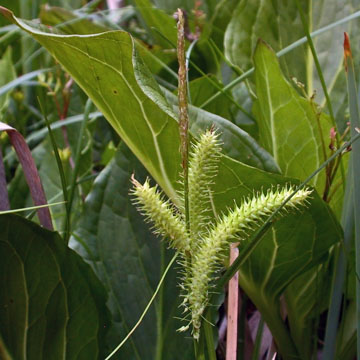

Carex schweinitzii - (image 1 of 3)
Taxonomy
Family: Cyperaceae
Section Vesicariae
Habitat
Calcareous fens, seeps, cold streams, in open or partially shaded areas.
Associates
Distribution
Ontario, VT, MA, CT, NY, PA, MI, WI, RI (extirpated) and VA. A disjunct collection from MO is suspect and may be the result of a label mixup. Reports from NC, TN, and NJ are thought to be the result of misidentifications.
Morphology
Perennial, colonial from long rhizomes; stems 30-70 cm, aphyllopodic, sharply triangular, arising singly or few together from the rhizomes; leaves mostly 4-10 mm wide, very rough distally; terminal spike staminate, slender-pedunculate, usually with a conspicuous bracts or smaller sessile spike some distance below, the scales acute or cuspidate; pistillate spikes 2-5, approximate or the lowest widely separate, cylindric, 3-8 cm long and 1-1.5 cm thick, the lowest spreading or ascending and distinctly pedunculate, the upper ascending to erect, short-pedunculate or subsessile; lower bracts leaf-like, sheathing at the base, much surpassing the inflorescence; pistillate scales with small, entire, hyaline or brown-tinged body, the midvein excurrent into a rough awn often equaling or surpassing the perigynium; perigynia spreading or ascending, 5.5-7.2 mm long, substipitate, ovoid, inflated, with 7-11 faint nerves, abruptly narrowed to a slender beak 1.4-2.4 mm long, with straight or slightly spreading teeth 0.2-0.5 mm long; achene pale brown, loosely enveloped, concavely trigonous, with a persistent flexuous style.
Notes
Fruiting June to July
Wetland indicator: OBL
This species is endemic to the northeast and may be most abundant in central NY, though there are many populations in Michigan and Ontario as well. It might be confused with C. utriculata but is usually of shorter stature. The long, slender awns of the lower pistillate scales, lack of awns on the staminate scales, and elongate rhizomes help distinguish it from similar species. The elongate lower pistillate spikes also tend to flex outward or downward from the middle.
References
Ball, P.W. and A.A. Reznicek. 2002. Carex, In: Flora of North America Editorial Committee, Eds. Flora of North America North of Mexico. Volume 23. Oxford University Press, New York.
Gleason, Henry A. and A. Cronquist. 1991. Manual of Vascular Plants of
Northeastern United States and Adjacent Canada. Second Ed.
The New York Botanical Garden. Bronx, NY
|
© Michael Hough 2018 |